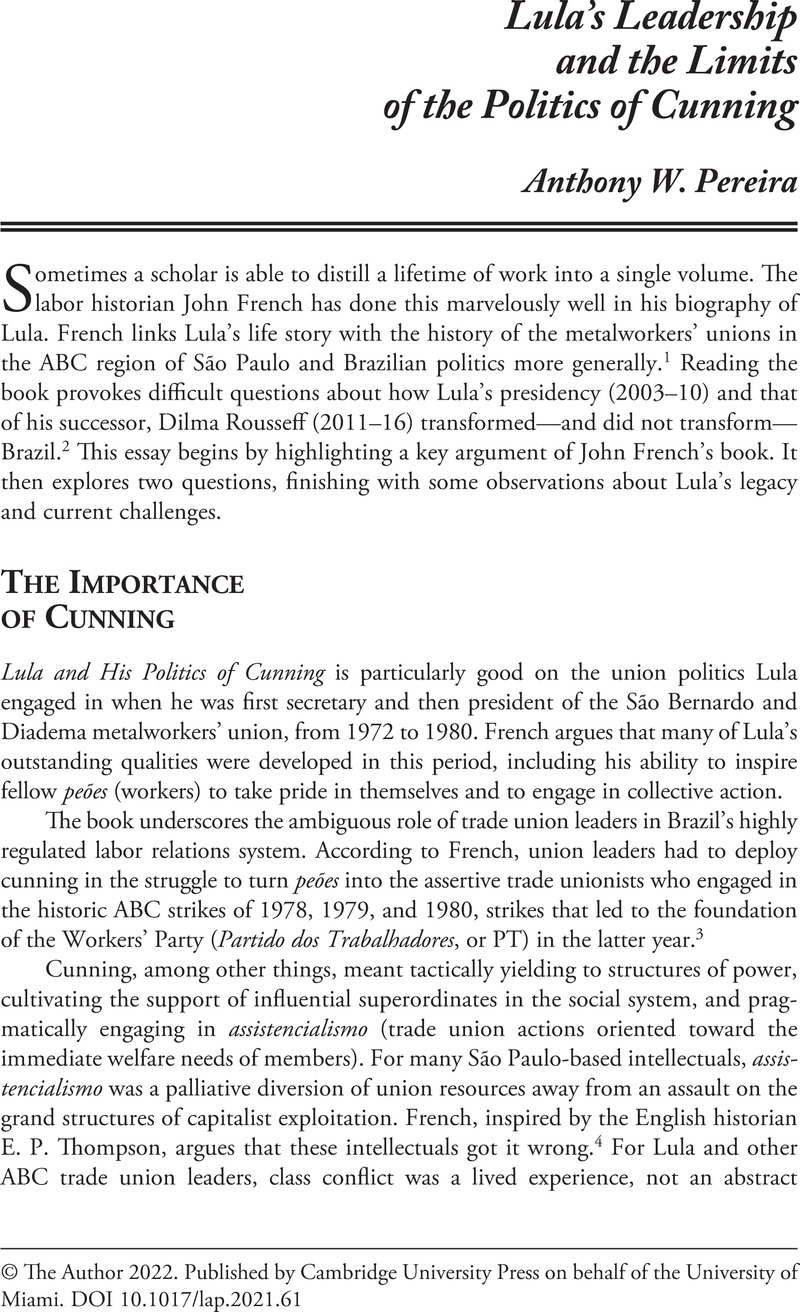No CrossRef data available.
Article contents
Lula’s Leadership and the Limits of the Politics of Cunning
Published online by Cambridge University Press: 07 February 2022
Abstract
An abstract is not available for this content so a preview has been provided. Please use the Get access link above for information on how to access this content.

- Type
- Symposium: Lula and His Politics of Cunning: From Metalworker to President of Brazil by John D. French
- Information
- Copyright
- © The Author 2022. Published by Cambridge University Press on behalf of the University of Miami
References
Countryeconomy.com. Brazil Government Budget Deficit % of GDP. Database. https://countryeconomy.com. Accessed August 4, 2021.Google Scholar
French, John. 1992. The Brazilian Workers’ ABC: Class Conflict and Alliances in Modern São Paulo. Chapel Hill: University of North Carolina Press.Google Scholar
Keck, Margaret. 2009. The Workers’ Party and Democratization in Brazil. New Haven: Yale University Press.Google Scholar
Lavinas, Lena. 2013. 21st Century Welfare. New Left Review 84 (November—December): 5–40.Google Scholar
Loureiro, Pedro Mendes. 2018. The Ebb and Flow of the Pink Tide: Reformist Development Strategies in Brazil and Argentina. Ph.D. thesis, Department of Development Studies, School of Oriental and African Studies, University of London.Google Scholar
Nicolau, Jairo. 2020. O Brasil dobrou à direita: uma radiografia da eleição de Bolsonaro em 2018. Rio de Janeiro: Zahar.Google Scholar
Oliveira, Francisco de. 2006. Lula in the Labyrinth. New Left Review 42 (November–December): 5–22.Google Scholar
Pereira, Anthony W. 2020. Modern Brazil: A Very Short Introduction. Oxford: Oxford University Press.CrossRefGoogle Scholar
Pereira, Paulo Celso. 2015. Molon sai do PT com críticas ao partido e vai para Rede de Marina. O Globo no. 29999, September 25, País, p. 4. www2.senado.leg.br Accessed July 29, 2021. Also https://oglobo.globo.com/politica/molon-deixa-pt-vai-se-filiarrede-sustentabilidade-de-marina-silva-17596775. Accessed November 13, 2021.Google Scholar
Reuters. 2013. Alvo de protestos, Cabral diz se inspirar em papa e promete ser mais humilde. July 29. https://www.reuters.com/article/brazil-politica-cabral-meaculpa-idBRSPE96S07720130729. Accessed August 5, 2021.Google Scholar
Saad-Filho, Alfredo. 2003. New Dawn or False Start in Brazil? The Political Economy of Lula’s Election. Historical Materialism 11, 1: 3–21.Google Scholar
Saad-Filho, Alfredo, Grigera, Juan, and Paula Colombi, Ana. 2020. The Nature of PT Governments: A Variety of Neoliberalism? Latin American Perspectives 47, 230, no. 1 (January): 4–8.Google Scholar
Samuels, David and Zucco, Cesar. 2018. Partisans, Antipartisans and Nonpartisans: Voting Behavior in Brazil. Cambridge: Cambridge University Press.CrossRefGoogle Scholar
Statista. Brazil: Inflation Rate from 1986 to 2026. Website. https://www.statista.com/statistics/270812/inflation-rate-in-brazil. Accessed August 5, 2021.Google Scholar
Teixeira, Luiz. 2018. Auge e queda de Cabral: a “Farra dos Guardanapos” em Paris. Terra, August 1. https://www.terra.com.br/noticias/brasil/politica/lava-jato/por-tras-da-farrados-guardanapos-em-honra-a-sergio-cabral,8683c653912be33f5e93297216ac5ac4igg1c96m.html. Accessed August 5, 2021.Google Scholar
Thompson, E. P. 1978. The Poverty of Theory and Other Essays. New York: Monthly Review Press.Google Scholar
World Bank Open Data. GDP Growth (Annual %)–Brazil. Website. https://data.worldbank.org. Accessed August 4, 2021.Google Scholar




